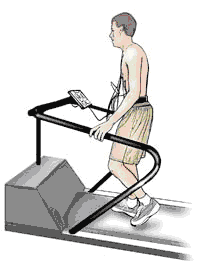Exercise stress test
 Alternative names
Alternative names
Exercise ECG; ECG - exercise treadmill; Stress ECG; Exercise electrocardiography; Stress test - exercise treadmill
Definition
An exercise stress test is a screening tool to test the effect of exercise on your heart. The test gives a general sense of how healthy your heart is and it is particularly useful in determining whether there are any blocked arteries.
How the test is performed
You will walk or pedal on an exercise machine while the electrical activity of your heart is measured with an electrocardiogram (ECG), and blood pressure readings are taken. This will measure your heart's reaction to your body's increased need for oxygen.
The test continues until you reach a target heart rate, unless complications such as chest pain or an exaggerated rise in blood pressure develop. You will continue to be monitored for 10 minutes after exercising, or until your heart rate returns to baseline.
How to prepare for the test
- You must not eat, smoke, or drink beverages containing caffeine or alcohol for 3 hours before the test.
- You should continue all medications unless instructed otherwise.
- Wear comfortable shoes and loose clothing to allow exercise.
Tell your doctor if you are taking sildenafil citrate (Viagra) and have taken a dose within the past 24 hours. This is necessary because nitroglycerin, which is sometimes given during a stress test to relieve chest pain, should not be given to a person who has recently taken Viagra, since the combination can cause a serious drop in blood pressure.
How the test will feel
Electrodes (conductive patches) will be placed on your chest, arms, and legs to record the heart's activity. The preparation of the electrode sites on your chest may produce a mild burning or stinging sensation. Sometimes in males, chest hair is shaven off to allow the electrodes to stick to the chest wall.
The blood pressure cuff on your arm will be inflated every few minutes, producing a squeezing sensation that may feel tight. Baseline measurements of heart rate and blood pressure will be taken before exercise starts.
You will start walking on a treadmill or pedalling a stationary bicycle. The pace and incline of the treadmill will gradually be increased.
Rarely, people experience chest discomfort, palpitations, dizziness, or shortness of breath during the test.
Why the test is performed
A stress test is performed to determine causes of chest pain, the exercise capacity of the heart, appropriate exercise levels in those beginning an exercise program, and to identify rhythm disturbances during exercise. There may be additional reasons that your doctor requests this test for eg. to screen for heart disease, particularly if there are risk factors for heart disease in the patient.
Normal Values
Normally, heart rate increases in proportion to the workload and attains endurance levels appropriate for age and conditioning level.
What abnormal results mean
Abnormal results may indicate arrhythmias during exercise, stress on the heart provoked by exercise, possible coronary artery disease (blockage in the arteries), or lack of aerobic fitness.
What the risks are
Stress tests are generally safe. Some patients may have chest pain or may faint or collapse. A heart attack or dangerous irregular rhythm rarely occurs, but if it does, the patient is in the best position to receive medical attention.
Patients who are likely to have such complications are usually already known to have weak hearts, so they are not given this test.
Special considerations
A stress test is less accurate in young or middle-aged women with symptoms that are not typical of heart disease.
Update Date: 11/6/2006
Updated by: Glenn Gandelman, MD, MPH, Assistant Clinical Professor of Medicine, New York Medical College, Valhalla, NY. Review provided by VeriMed Healthcare Network.
